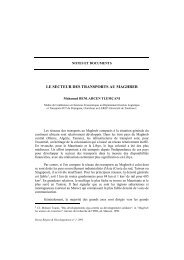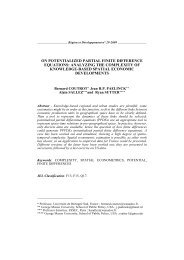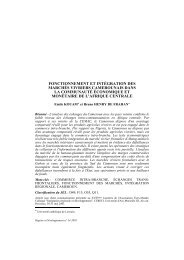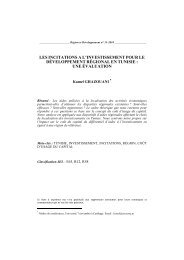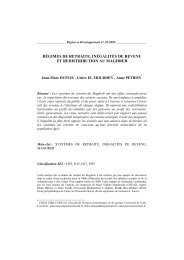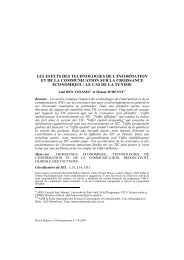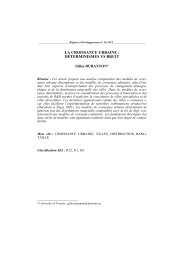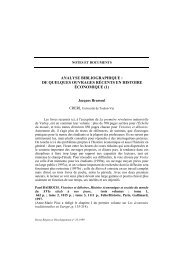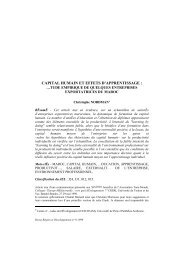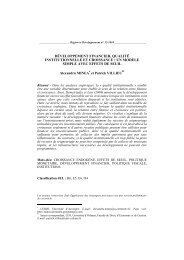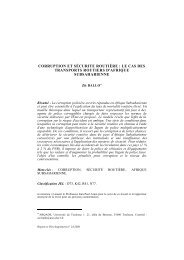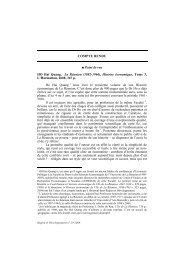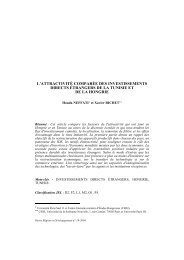space and growth: a survey of empirical evidence ... - ResearchGate
space and growth: a survey of empirical evidence ... - ResearchGate
space and growth: a survey of empirical evidence ... - ResearchGate
Create successful ePaper yourself
Turn your PDF publications into a flip-book with our unique Google optimized e-Paper software.
24 Maria Abreu, Henri L.F. de Groot <strong>and</strong> Raymond J.G.M. Floraxaverage per-capita GDP in neighboring regions) to detect two clusters <strong>of</strong> regionsin the European Union (North <strong>and</strong> South). A spatial regimes model indicatesthere is absolute convergence in the South, <strong>and</strong> absolute divergence in the North.However, spatial diagnostic tests reveal that the residuals are spatiallyautocorrelated, <strong>and</strong> that a spatial error model would be more appropriate. Theauthors therefore estimate a spatial regimes model with spatially autocorrelatederror terms.While exploratory spatial data techniques can help guide the choice <strong>of</strong>spatial regimes, there is a tendency in the spatial econometrics literature to relysolely on these methods when constructing the model. We would argue thatwhile the non-spatial econometrics literature can gain insights from conductingthese analyses, the spatial econometrics literature would benefit from linking thechoice <strong>of</strong> regimes more closely to theory, for example by basing the choice <strong>of</strong>regimes on variables with a spatial dimension such as latitude <strong>and</strong> climate. Thisis particularly important in view <strong>of</strong> the fact that there are no tests to distinguishbetween spatial dependence <strong>and</strong> spatial heterogeneity2. In fact, the two can beobservationally equivalent in single cross-section models (Anselin, 2001).Suppose we find a cluster <strong>of</strong> low-<strong>growth</strong> regions while conducting an exploratoryspatial data analysis. The cluster could be a result <strong>of</strong> spillovers from oneregion to another, or it could be due to similarities between regions in thevariables that affect <strong>growth</strong> (e.g., climate, technology, institutions). Note that ina panel data setting it is easier to distinguish between the two effects, sinceomitted variables with a spatial dimension can be picked up by region or countryfixed effects. Given the difficulties involved in estimating a panel-data modelusing spatial econometrics (see below), it is <strong>of</strong>ten advisable to consider thepossibility <strong>of</strong> spatial heterogeneity before proceeding to estimate a model <strong>of</strong>spatial dependence.The remainder <strong>of</strong> this section will be devoted to models <strong>of</strong> relativelocation. As we have mentioned before, the spatial econometrics literature on<strong>growth</strong> has tended to focus on methodological issues, <strong>and</strong> has frequentlyoverlooked theoretical <strong>and</strong> policy considerations. Exceptions to this rule are anumber <strong>of</strong> studies on technology diffusion <strong>and</strong> spillovers. López-Bazo et al.(2004) is an example <strong>of</strong> a spatial econometric study <strong>of</strong> technology diffusion,applied to the regions <strong>of</strong> the European Union. The level <strong>of</strong> technology in eachregion is assumed to depend on the technology <strong>of</strong> its neighbors, which is in turnrelated to neighbors' stocks <strong>of</strong> human <strong>and</strong> physical capital. The <strong>empirical</strong> modelis thus linked directly to theory, <strong>and</strong> the conclusions can give insights into theappropriateness <strong>of</strong> the theoretical model. The authors find that technology2 There are unidirectional tests for spatial heterogeneity <strong>and</strong> spatial dependence. The alternativehypothesis deals with either spatial heterogeneity or spatial dependence, <strong>and</strong> in order to distinguishbetween the two we would need a nested model.




